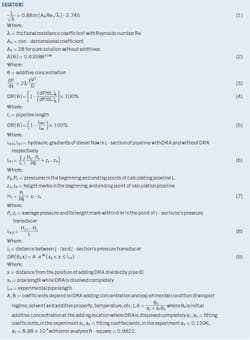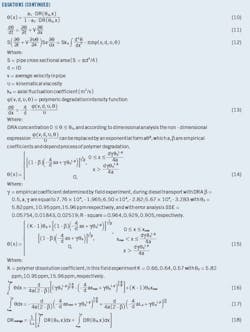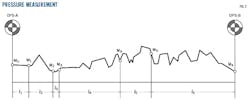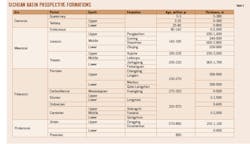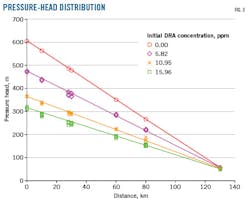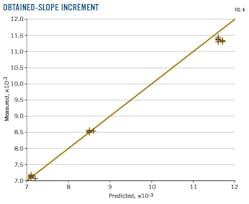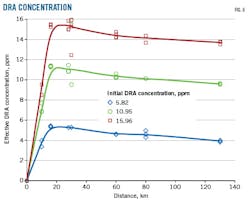Chen Yang
Li Changjun
Southwest Petroleum University
Chengdu, China.
A.M. Nechval
Ufa State Petroleum Technology University
Ufa, Russia
Yang Peng
Southwest Branch Co. of Sinopec
Chengdu
A. Yu. Zhukov
Kazan Federal University
Kazan, Russia
Formulating drag reducing agents' (DRA) average concentration and corresponding drag reduction efficiency can show that mechanical degradation of DRA not only occurs after its dissolution but also while dissolution is underway.
Most studies about polymer degradation in DRA have concentrated on the polymers' molecular construction and their chain scission during shear degradation. These studies, however, have used short pipes. Even field experiments were conducted in a 7.5-km pipe. Polymer degradation is a long process. This article's study was carried out in a 130-km commercial refined products pipeline.
Experimental procedure
All experiments used M-Flowtreat poly alpha olefin (PAO)(Oil & Gas Journal, May 1, 2017, p. 70). Tables 1 and 2 show the physical properties of the diesel and DRA respectively. The 130-km pipeline had 20-in. OD and relative roughness, ε, = 8.92 × 10-5. Experiments used 5.82-15.96 ppm DRA, inducing 28-55% drag reduction.
To exclude the pump's shear action on additives, the field experiment occurred between two stations, adding DRA after the first pump, with pressure measurement done at the beginning and end of pipeline (Fig. 1). Pressure drops on each section of the pipe were measured with absolute-pressure transducers (Fig. 2, Table 3).
The experiment lasted 84 hr in steady-state conditions, with an average flow of Q = 1,231.94 cu m/hr. It took 6 hr to administer the DRA (Figs. 3-4).
Fig. 5 shows pressure head distribution along the pipeline with different additive concentrations and after pressure correction for measuring error and hydraulic slope.
Results
Evaluation of the PAO's frictional resistance coefficient, λ, used Equation 1. With the addition of DRA the value A0 increases. On the basis of experimental data, Equation 2 expresses A0 by empirical equation θ, with R-square = 0.9931.
Fig. 6 compares the slope increment obtained through the predicting model with the experimental measured data, showing an error <0.5%. Therefore, in pipeline transportation, diesel pressure drop dP/dx can be expressed as shown in Equation 3.
Definitions
With constant flow Q = idem, Equation 4 can calculate drag reduction efficiency. Different heights of experimental pipe section in this experiment allow confirmation of drag reduction efficiency via Equation 5.
Equation 6 calculated hydraulic gradient without DRA while diesel was being transported. Average pressure was calculated within 6 hr for a given DRA concentration, θ0, in stationary condition. Equation 7 expresses pressure and elevation head in the point of j-section's pressure transducer, relative to the head at the beginning of the pipeline (M0).
Equation 8 confirms hydraulic gradient while transporting diesel with DRA. Therefore, according to Equation 5, drag reduction efficiency and its asymptote are shown in Fig. 5.
Jouenne considered there was no mechanical degradation for velocities lower than a certain value regardless of the polymer concentration in his experimental range. The field experiment seemed to be incorrect. Jouenne, however, didn't account for degradation due to the short experimental distance (7.5 km).
On a 130-km scale, the drag reduction process can be divided into two parts: dissolution and degradation (Fig. 6). Field experiments, however, indicated that in the process of dissolution polymer additive degradation is also happening. Fig. 7 shows that the curve gradually drops after peak value, allowing the degradation process to be expressed by Equation 9.
Equation 9, therefore, can easily calculate initial drag reduction efficiency, while Equation 10 shows DRA concentration, θ, during diesel oil transport at distance X from the position of adding the DRA.
Fig. 6 shows the change of PAO concentration by transport distance during the field experiment. In the first 20 km of pipe DRA is gradually dissolving and, after the peak value, additive concentration is gradually decreasing, which can be explained by polymer mechanical degradation. Since the field experiment was carried out at normal temperature, temperature's influence on mechanical degradation was not considered.
Equation 11 expresses the material concentration derivative. Ignoring the axial fluctuation of polymeric concentration in the pipe and treating transportation as a steady flow allows treating the whole process as one-dimensional flow. Under these conditions, Equation 12 confirms in-pipe DRA concentration.
Assuming axial fluctuation of polymeric concentration was ignored allows simplifying Equation 12 as Equation 13. Logarithmic non-dimensional form is considered, but the obtained θ(x) fits the experimental data poorly. Applying αθβ to replace Equation 13's dimensional expression lets θ(x) be calculated by Equation 14.
Fig. 6 shows that in the dissolving process additive concentration linearly increases with transport distance. Therefore, in combination with the dissolving process, the whole transport process with DRA can be expressed by Equation 15.
DRA concentration, efficiency
In accordance with Equation 15, the integration of θ(x) in the diesel oil pipeline (L0 = 130 km) can be obtained via Equations 16 and 17. According to Equation 10, DR(ϴ0, x) = ϴ(x)/a1+a2 ϴ(x)2, therefore average drag reduction efficiency could be expressed as Equation 18.
Acknowledgent
We would like to acknowledge support from Mirriko Co. and assistance from the Southwest Branch Co. of Sinopec. This study was financially supported by the subproject of the National Science and Technology Major Project of China (No.2016ZX05028-001-006); the National Natural Science Foundation of China (No.51474184, No.51504026); Research Project of the Education Department of Sichuan Province (No.15ZB0050), and China Scholarship Council.Bibliography
Bhambri, P., Narain, R., Fleck, B.A., "Thermo‐responsive polymers for drag reduction in turbulent Taylor-Couette flow," Journal of Applied Polymer Science, Vol. 133, No. 46, Aug. 3, 2016.
Boelens, A.M. and Muthukumar, M., "Rotational relaxation time as unifying time scale for polymer and fiber drag reduction," Physical Review E, Vol. 93, No. 5-1, May 13, 2016, 052503.
Brostow, W., "Drag reduction in flow: Review of applications, mechanism and prediction," Journal of Industrial & Engineering Chemistry, Vol. 14, No. 4, April 2008, pp. 409-416.
Brun, N.L., Zadrazil, I., Norman, L., Bismarck, A., and Markides, C.N., "On the drag reduction effect and shear stability of improved acrylamide copolymers for enhanced hydraulic fracturing," Chemical Engineering Science, Vol. 146, June 2, 2016, pp. 135-143.
Dupas, A., Hénaut, I., Argillier, J.F., and Aubry, T., "Mechanical Degradation Onset of Polyethylene Oxide Used as a Hydrosoluble Model Polymer for Enhanced Oil Recovery," Oil & Gas Science & Technology, Vol. 67, No. 6, pp. 931-940, June 2013.
Elbing, B.R., Winkel, E.S., Solomon, M.J., and Ceccio, S.L., "Degradation of homogeneous polymer solutions in high shear turbulent pipe flow," Experiments in Fluids, Vol. 47, No. 6, June 2009, pp. 1033-1044.
Eshrati, M., Al-Wahaibi, T., Al-Hashmi, A.R., Al-Wahaibi, Y., Al-Ajmi, A., and Abubakar, A., "Experimental study of drag reduction of polymer-polymer mixtures in horizontal dispersed oil-water flow," Experimental Thermal & Fluid Science, Vol. 83, May 1, 2017, pp. 169-176.
Fsadni, A.M., Whitty, J.P.M., and Stables, M.A., "A brief review on frictional pressure drop reduction studies for laminar and turbulent flow in helically coiled tubes," Applied Thermal Engineering," Vol. 109, Oct. 25, 2016, pp. 334-343.
Fujimura, M., Atsumi, T., Mamori, H., Iwamoto, K., Murata, A., Masuda, M., and Ando, H., "Numerical simulation of drag-reducing channel flow by using bead-spring chain model," International Journal of Heat & Fluid Flow, Vol. 63, February 2017, pp. 75-87.
Habibpour, M., Koteeswaran, S., and Clark, P.E., "Drag reduction behavior of hydrolyzed polyacrylamide/polysaccharide mixed polymer solutions-effect of solution salinity and polymer concentration," Rheologica Acta, Vol. 56, No. 7, July 2017, pp. 1-12.
Hidema, R., Suzuki, H., Murao, I., Hisamatsu, S., and Komoda, Y., "Effects of Extensional Rates on Anisotropic Structures and Characteristic Scales of Two-Dimensional Turbulence in Polymer Solutions," Flow Turbulence & Combustion, Vol. 96, No. 1, January 2016, pp. 1-18.
Ivchenko, P.V., Nifant'Ev, I. E., and Tavtorkin, A.V., "Polyolefin drag reducing agents," Petroleum Chemistry, Vol. 56, No. 9, September 2016, pp. 775-787.
Jouenne, S., Anfray, J., Cordelier, P.R., Mateen, K., Levitt, D., Souilem, I., Marchal, P., Lemaitre, C., Choplin, L., Nesvik, J., and Waldman, T., "Degradation (or lack thereof) and drag reduction of HPAM Solutions during transport in turbulent flow in pipelines," Oil and Gas Facilities, Vol. 4, No. 1, February 2015, pp. 80-92.
Lurie, M.V., Arbuzov, N.S., and Oksengendler, S.M., "Transmission of liquids with anti-turbulent additives," Oil and Oil Products Pipeline Transportation: Science & Technologies, Vol. 2, No. 2, April 2012, pp. 56-60.
Lurie, M.V. and Golunov, N.N., "Application of bench test results of small anti-turbulent additives for industrial pipeline hydraulic analysis," Oil and Oil Products Pipeline Transportation: Science & Technologies, Vol. 2, No. 4, October 2012, pp. 32-37.
Mortazavi, S.M.M., "Correlation of polymerization conditions with drag reduction efficiency of poly(1-hexene) in oil pipelines," Iranian Polymer Journal, Vol. 25, No. 8, August 2016, pp. 1-7.
Nghe, P., Tabeling, P., and Ajdari, A., "Flow-induced polymer degradation probed by a high throughput microfluidic set-up," Journal of Non-Newtonian Fluid Mechanics, Vol. 165, No. 7-8, July-August 2010, pp. 313-322.
Owolabi, B.E., Dennis, D.J.C., and Poole, R.J., "Turbulent drag reduction by polymer additives in parallel-shear flows," Journal of Fluid Mechanics, Vol. 827, Sept. 25, 2017.
Pereira, A.S., Mompean, G., Thais, L., Soares, E.J., and Thompson, R.L., "Active and hibernating turbulence in drag-reducing plane Couette flows," Physical Review Fluids, Vol. 2, No. 8, Aug. 21, 2017.
Pereira, A.S., Mompean, G., Thais, L., and Thompson, R.L., "Statistics and tensor analysis of polymer coil-stretch mechanism in turbulent drag reducing channel flow," Journal of Fluid Mechanics, Vol. 824, Aug. 10, 2017, pp. 135-173.
Quitry, A.D.C. and Ouellette, N.T., "Concentration effects on turbulence in dilute polymer solutions far from walls," Physical Review E, Vol. 93, No. 6, June 2016, 063116.
Sandoval, G.A.B. and Soares, E.J., "Effect of combined polymers on the loss of efficiency caused by mechanical degradation in drag reducing flows through straight tubes," Rheologica Acta, Vol. 55, No. 7., July 2016, pp. 1-11.
Tamano, S., Ikarashi, H., Morinishi, Y., and Taga, K., "Drag reduction and degradation of nonionic surfactant solutions with organic acid in turbulent pipe flow," Journal of Non-Newtonian Fluid Mechanics, Vol. 215, 2015, pp. 1-7.
Wang, L., Wang, D., Shen, Y., Lai, X.J., and Guo, X., "Study on properties of hydrophobic associating polymer as drag reduction agent for fracturing fluid," Journal of Polymer Research, Vol. 23, No. 11, November 2016, pp. 1-8.
The authors
Chen Yang ([email protected]) is a researcher in State Key Laboratory of Oil and Gas Reservoir Geology and Exploitation, Southwest Petroleum University, Chengdu, China. She has also served as a researcher in Ufa State Petroleum Technology University, Ufa, Russia. She holds PhDs from Southwest Petroleum University and Ufa State Petroleum Technology University. She is a member of Society of Petroleum Engineers (SPE).
Li Changjun ([email protected]) is the chief of the Oil-Gas Storage and Transportation Department, Southwest Petroleum University, Chengdu. He holds a PhD from Southwest Petroleum University. He is a member of Chinese Petroleum Society (CPS).
A.M. Nechval ([email protected]) is a PhD supervisor in Ufa State Petroleum Technology University, from which he holds a PhD.
Yang Peng ([email protected]) is a senior engineer of Southwest Branch Co. of Sinopec, Chengdu. He previously served as an engineer of Northwest Branch Co. of Sinopec, Urumqi, China. He holds a PhD from Southwest Petroleum University. He is a member of Society of Petroleum Engineers (SPE).
A. Yu. Zhukov ([email protected]) is a senior researcher in Kazan Federal University, Tartarstan, Russia, from which he holds a PhD.



